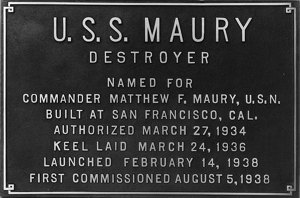

One of four 1,500-ton destroyers of the Gridley class, Maury was laid down 24 March 1936 by Union Plant, Bethlehem Shipbuilding Corp., San Francisco, California and sponsored at her commissioning by Miss Virginia Lee Maury Werth, granddaughter of Commodore Maury.
Through the late 1930s and into the 1940s, Maury served as flagship of DesDiv 11, which consisted of the other three ships of her class, Gridley, Craven and McCall. As part of DesRon 6, DesDiv 11 participated in exercises and other fleet activities in the Pacific Ocean, and was at sea with carrier Enterprise (CV 6) during the 7 December 1941 attack on Pearl Harbor.
For the first 10 months of the war, Maury continued screening carriers in raids on the Marshall Islands and Wake (when she helped sink a Japanese picket boat), the Battle of Midway in early June, the invasion of Guadalcanal and Tulagi in early August, the Battle of the Eastern Solomons later that month, and the Battle of the Santa Cruz Islands in October.

In November 1942, as the campaign to hold Guadalcanal approached a climax, Maury was assigned to Task Force 67, assigned to block Japanese attempts to reinforce their troops ashore. On 30 November, this force of five cruisers and destroyers Fletcher, Drayton, Maury and Perkins in the van, with hastily attached Lamson and Lardner in the rear, surprised eight Japanese destroyers in the Battle of Tassafaronga, yet lost one cruiser with three others badly damaged by torpedoes—Maury was not hit.
Maury continued to serve in the Solomons until August 1943, taking part in escort missions and two major night surface engagements: the Battle of Kolombangara with Capt. Thomas J. Ryan’s DesRon 12 on 12–13 July 1943 and what Adm. Nimitz later called a “little classic of naval warfare,” the Battle of Vella Gulf on 6–7 August, in which she, following Dunlap (flagship of Comdr. Frederick Moosbrugger, ComDesDiv 12) and Craven torpedoed four Japanese destroyers in a single salvo, sinking three without being hit themselves.

Following shipyard work on the west coast, Maury returned to the war zone in time to participate in the Gilberts and Marshalls invasions, November 1943 to February 1944. Over the next several months, she screened aircraft carriers in raids throughout the central Pacific, during the Battle of the Philippine Sea in June, and during the associated operations to capture islands in the Marianas. From September into November 1944, Maury's carrier escort duty continued during the Palaus operation, western Pacific air strikes and the Battle of Leyte Gulf.
In January and early February 1945, Maury participated in the invasion of Luzon and subsequent operations in the Philippines, before returning to to Hawaii. She served in that area for several weeks, then departed for New York via the Panama Canal, arriving in June. She was decommissioned in October, struck from the Naval Register 1 November, sold to Hugo Neu, New York, 13 June 1946, resold shortly thereafter to Northern Metal Co., Philadelphia and scrapped.
In addition to the Presidential Unit Citation, Maury earned 16 battle stars during World War II.
Sources: Capt. R.S. Crenshaw, Jr., DANFS, Naval Historical Center